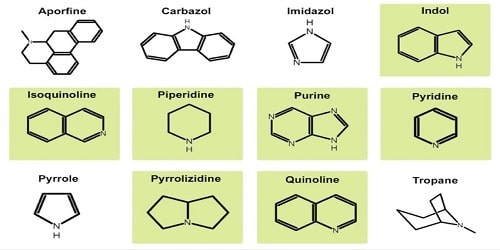Alkaloid Meaning
The term alkaloid was coined as “alkaloid” in 1818 by the German pharmacist Karl Friedrich Wilhelm Meissner, uniting the terms “alkalis” which refers to alkaline carbonates and “–oid” which alludes to a similarity.
In general, alkaloids come from plants, being secondary metabolites of them, synthesized. Protoalkaloids are those of animal origin. They are water-soluble at acidic pH and soluble in organic solvents at alkaline pH. Those that are considered true are derived from an amino acid, and are nitrogenous, generally having great physiological action on animal organisms and man, being psychoactive. Among the best-known alkaloids, we can name caffeine, nicotine, codeine, theine, mateine, morphine, and quinine, with cocaine being the first alkaloid to be synthesized. The American aborigines, such as the Mayans, already used them for therapeutic purposes (they can act as analgesics, stimulants or pain relievers) and rituals. They act on the nervous system, especially the central one. Some can cause excitement, like cocaine, and others, depression, like morphine. They can be highly toxic, depending on their type and the dose ingested. We find, for example, aconite, in aconitine, which is very poisonous.
In its beginnings, to be an alkaloid, it was required to present a heterocyclic system; but later others were included, with simple structures, such as ephedrine. Alkaloids of animal origin were also isolated.
In 1960, alkaloids were classified as follows by Hegnauer:
1. True alkaloids: they are secondary metabolites that contain a heterocyclic nitrogen, with a carbon skeleton, coming, partially or totally, from a proteinaceous amino acid.
2. Pseudoalkaloids, they have nitrogen but do not come from a protein amino acid.
3. Protoalkaloids, which, although they are formed from a protein amino acid, do not form a heterocyclic system.
4. Secoalkaloid, coming from a true alkaloid, but where an open chain nitrogen group is formed, due to cleavage of the heterocyclic ring.
Alkaloid Meaning in Hindi
एल्कलॉइड(Alkaloid) शब्द को 1818 में जर्मन फार्मासिस्ट कार्ल फ्रेडरिक विल्हेम मीस्नर द्वारा “एल्कलॉइड” के रूप में गढ़ा गया था, जो “क्षार” शब्दों को जोड़ता है जो क्षारीय कार्बोनेट को संदर्भित करता है और “-ऑइड” जो समानता को दर्शाता है।
सामान्य तौर पर, एल्कलॉइड पौधों से आते हैं, जो उनके द्वितीयक मेटाबोलाइट होते हैं, जिन्हें संश्लेषित किया जाता है। प्रोटोएल्कलॉइड जानवरों की उत्पत्ति के होते हैं। वे अम्लीय पीएच पर पानी में घुलनशील होते हैं और क्षारीय पीएच पर कार्बनिक सॉल्वैंट्स में घुलनशील होते हैं। जिन्हें सही माना जाता है वे एक एमिनो एसिड से प्राप्त होते हैं, और नाइट्रोजनयुक्त होते हैं, आम तौर पर जानवरों के जीवों और मनुष्य पर बहुत अधिक शारीरिक क्रिया करते हैं, जो मनोवैज्ञानिक होते हैं। सबसे प्रसिद्ध एल्कलॉइड में, हम कैफीन, निकोटीन, कोडीन, थीन, मैटीन, मॉर्फिन और क्विनिन का नाम ले सकते हैं, जिसमें कोकेन संश्लेषित होने वाला पहला एल्कलॉइड है। मायान जैसे अमेरिकी आदिवासी पहले से ही उन्हें चिकित्सीय उद्देश्यों (वे एनाल्जेसिक, उत्तेजक या दर्द निवारक के रूप में कार्य कर सकते हैं) और अनुष्ठानों के लिए उपयोग करते थे। वे तंत्रिका तंत्र, विशेष रूप से केंद्रीय तंत्र पर कार्य करते हैं। कुछ उत्तेजना पैदा कर सकते हैं, जैसे कोकेन, और अन्य अवसाद, जैसे मॉर्फिन। वे अपने प्रकार और अंतर्ग्रहण की गई खुराक के आधार पर अत्यधिक विषैले हो सकते हैं। उदाहरण के लिए, हम एकोनाइट को एकोनाइटिन में पाते हैं, जो बहुत जहरीला होता है।
इसकी शुरुआत में, एक अल्कलॉइड होने के लिए, एक हेट्रोसाइक्लिक सिस्टम प्रस्तुत करना आवश्यक था; लेकिन बाद में इफेड्रिन जैसे सरल संरचनाओं के साथ अन्य को भी शामिल किया गया। पशु मूल के अल्कलॉइड को भी अलग किया गया।
1960 में, हेग्नाउर द्वारा अल्कलॉइड को निम्नानुसार वर्गीकृत किया गया था:
1. सच्चे अल्कलॉइड: वे द्वितीयक मेटाबोलाइट्स हैं जिनमें एक हेट्रोसाइक्लिक नाइट्रोजन होता है, जिसमें कार्बन कंकाल होता है, जो आंशिक रूप से या पूरी तरह से प्रोटीनयुक्त अमीनो एसिड से आता है।
2. स्यूडोएल्कलॉइड, इनमें नाइट्रोजन होता है लेकिन ये प्रोटीन एमिनो एसिड से नहीं आते हैं।
3. प्रोटोएल्कलॉइड, जो प्रोटीन एमिनो एसिड से बनने के बावजूद हेट्रोसाइक्लिक सिस्टम नहीं बनाते हैं।
4. सेकोएल्कलॉइड, ये एक सच्चे एल्कलॉइड से आते हैं, लेकिन इनमें हेट्रोसाइक्लिक रिंग के विभाजन के कारण एक ओपन चेन नाइट्रोजन समूह बनता है।

